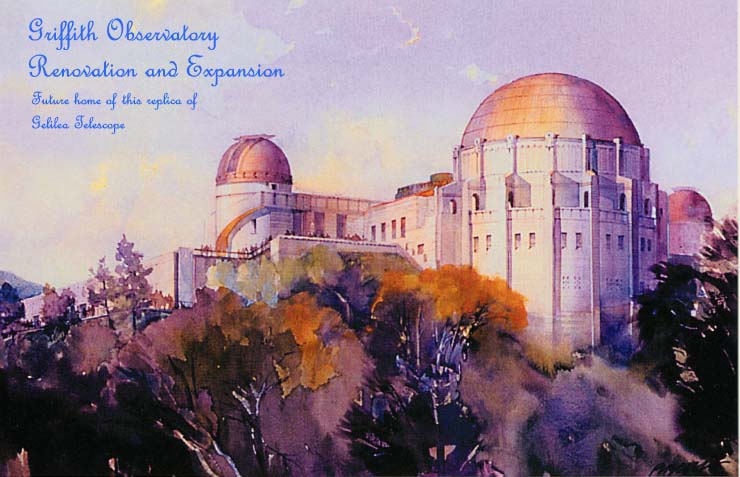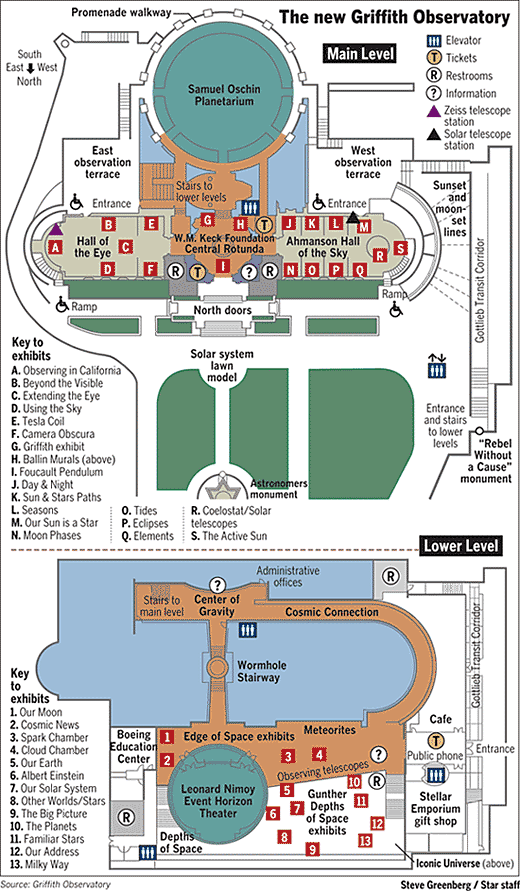A Human-Centered Cosmos in Domes to the Stars

Warren Aerial Photography
The Griffith Observatory in Los Angeles reopens tomorrow.
... all the exhibits remain deliberately human centered; they encourage observation and are about observation.
Observatory Review | 'Griffith Observatory'
LOS ANGELES, Oct. 28 — Walk into the central rotunda of the expanded Griffith Observatory — the Los Angeles landmark that is to reopen Friday after being closed almost five years and undergoing $93 million of reconstruction — and gaze up at the domed ceiling. You will see what 70 million visitors have glimpsed since the observatory opened in 1935, high above the city’s ever-expanding grid and sprawl: stern Jupiter grasping his thunderbolt, Atlas bearing the weight of the Zodiac, Mercury soaring, and Venus reclining. These are the heavenly bodies in their original mythological incarnations: gods and goddesses deploying stupendous and mystifying powers.
As for seeing the stars in more realistic celestial domes, you will have to wait until night to look through the observatory’s 12-inch Zeiss telescope, or enter the new Samuel Oschin Planetarium, just past the rotunda, within which a custom-modified, Zeiss Universarium Mark IX projector will shine its technologically refined images on an aluminum dome above 300 reclining seats.
In the midst of celebrations of the Griffith’s return, such new attractions — including an expansive lower level of exhibition space carved underneath the original building — may get much of the attention. But Hugo Ballin’s original ceiling and murals in the rotunda reveal something more important. For this reconstruction is most remarkable not for what has changed, but for what has stayed the same. And that is a radical approach in the world of science exhibitions.
The rotunda’s ceiling holds the key. It shows not what the sky actually is but what humans once made of it, how it was observed and interpreted. Below it are eight murals, newly restored, that portray scientific advances that led to ever more subtle understandings: metallurgists, engineers and mathematicians, in busy colloquy, shape the cosmos through the millenniums.
What is being portrayed is the classical human-centered universe. This is the very world that gave birth to the modern planetarium, in which the observer sits — gazing upward, learning how to interpret what is seen — as the universe moves around him in a sky dome that could well have been designed by Ptolemy.

Stephanie Diani for The New York Times
The central rotunda, showing the original artwork by Hugo Ballin.
When these murals were installed, the Griffith was only the third major planetarium in the United States. (Chicago and Philadelphia came first; the Hayden Planetarium in New York followed a few months later, all using Zeiss equipment.) Built with funds bequeathed to the city by a wealthy Welsh immigrant, Griffith J. Griffith (1850-1919), the observatory is operated by the Los Angeles Department of Recreation and Parks as a public institution with free admission.
The Griffith’s portrayal of a human-centered universe was shared with other planetariums in the 1930’s, including the Hayden, which also had a lobby with mythological allusions, and a planetarium show, complete with Manhattan’s skyline. These new institutions also linked astronomy to the progressive populism of their era: knowledge about the heavens would inspire another generation of stargazers and explorers, leading to as yet unimagined possibilities.
But this is a very different time, and anything might have happened as the Griffith expanded. (Construction was financed in nearly equal portions by the city, voter-approved bonds and private donations.) In New York the Rose Center for Earth and Space, for example, the reinvention of the Hayden, rejected the perspective of human-centered mythology and looked through the opposite end of the telescope, emphasizing the insignificance of the human, dissolving Hayden’s home into galactic mist.
Something even more unpredictable might have happened here. After all, the Griffith has no affiliation with a university or research institution to provide an anchor. During reconstruction (the architects were Pfeiffer Partners), the building itself was raised by hydraulic lifts so the mountain beneath could be excavated, creating new exhibition areas and a 200-seat hall for shows and lectures, expanding 27,000 square feet of internal space into 67,000.
The only thing that couldn’t change was the observatory’s mission and the classic appearance of this Art Deco building, a landmark that has appeared in science-fiction movies accompanied by figures ranging from Gene Autry to Arnold Schwarzenegger, that had a cameo role in “Rebel Without a Cause,” and that defines the skyline for parts of Los Angeles.
Many institutions have given in to far lesser temptations by seeking to increase the size of their audience or alter their tone with flashier amusements or pander to lowered expectations with condescension. Yet what happened here? Griffith’s director, Edwin C. Krupp, told The Los Angeles Times earlier this year that the observatory “won’t be in the mainstream of exhibition design at science centers, astronomy museums or any kind of museums.” And it isn’t. It is retrograde in every sense.
That is one of its virtues.
That doesn’t mean it isn’t flawed, but it does mean that the exhibitions by C&G Partners rather courageously turn their back on contemporary pressures in the museum world. One alcove, the Hall of the Sky, contains simple mechanical models mounted overhead that demonstrate the phases of the moon or how the tilt of the Earth’s axis creates its seasons. In another, live images of the sun’s surface are projected through the observatory’s solar telescope. Another gallery, the Hall of the Eye, displays the evolution of the telescope with panels, dioramas and cases, and shows how California became an “Alexandria” of astronomical research in the 20th century.
The entire first floor has a quaint clarity. No display tries too much; all will be supplemented by guides offering assistance and information. The most dramatic exhibit is a relic of the original Griffith but bears little relation to the heavens: a Tesla coil housed in a metal cage, whose lightninglike sparks may provide the Griffith’s only spectacle aside from the stars. But all the exhibits remain deliberately human centered; they encourage observation and are about observation.
The new lower level, evoking the expanse of the universe in its cavernous space, is less coherent, but the observer remains central. Traditional panels describe the planets, which are arrayed in proportional size; an interactive computer screen highlights other planetary systems.
The most imposing exhibit, the Big Picture, is an image of what might be hidden behind your finger if held about a foot from your face against the night sky, as demonstrated by a bronze Einstein on a bench, his finger aloft. That strip of eclipsed space becomes a 152-foot-long, 20-foot-high photo of the heavens in porcelain enamel, its 114 panels mounted against the wall, showing the myriad galaxies, quasars and other celestial bodies visible in a finger’s breadth of our perceptible world.
As it turns out, the Big Picture is less interesting visually than conceptually. It does not, in itself, inspire a sense of awe at the heavens. That is reserved for the moment when, in a traditional planetarium, the twilight sky darkens, the overhead dome seems to dissolve, and one gazes upward at a boundless expanse.
But that sensation too is promised. The Griffith’s new planetarium show was still being worked on during my visit, but Mr. Krupp said it would be in keeping with the mythic possibilities of the rotunda, dramatizing a history of our understanding of the universe. Most remarkably, it will have a live narrator, leading the audience on a guided celestial tour. Human centered indeed.
Perhaps the observatory’s only misstep was in giving its bust of James Dean such pride of place on the front lawn, overlooking the famed Hollywood sign on a nearby hill. Why Mr. Dean? Because in “Rebel Without a Cause” the Griffith plays a crucial role. Mr. Dean’s character comes in contact with the full scope of 1950s teenage brutality and anomie right after a planetarium show in which the cosmic destruction of the Earth is portrayed.
“In all the immensity of our universe and the galaxies beyond,” says the lecturer below the projected dome of stars, “the Earth will not be missed. Through the infinite reaches of space, the problems of man seem trivial and naïve indeed. And man, existing alone, seems an episode of little consequence.”
That message might have encouraged the nihilistic violence of the movie’s disaffected characters; or it might have grated against their adolescent convictions about the immensity of their problems when compared with humanity’s “episode of little consequence.” But why should the Griffith have given Mr. Dean such credit? The observatory’s real message is just the opposite.
Copyright 2006 The New York Times Company
***-
November 2nd, 2006, 04:42 PM #2

Griffith Observatory, Los Angeles

Jose Azel/Woodfin Camp and Associates, Inc.
High above the smog of central Los Angeles, Griffith Observatory has a much clearer view
of the stars than the rest of the city. The world-famous observatory is perched high
in the Hollywood Hills, in Griffith Park, a large park in the middle of the huge metropolis.

www.robertlandau.com
L.A. Hllywd. Griffith Observatory

Photo: Henry E. Huntington Memorial Library
http://english.glendale.cc.ca.us/obsopen.html
The steel skeleton frame of the Griffith Observatory's main dome
takes shape in this December 1933 photo.
The building opened 17 months later.

Pfeiffer Partners

-
November 3rd, 2006, 02:46 AM #3

Thanks lofter!!! What a well-written article and, more importantly, what a refreshingly un-trendy approach to an important renovation. No crappy pesudo-science displays, no obligatory, tiresome new concrete and glass "we are so hip, so today, so kewl" addition. And what an institution: a municipally-owned and -operated, no-fee place where all can be taught, uplifted. Wow.
-
November 3rd, 2006, 12:15 PM #4Forum Veteran

- Join Date
- Oct 2002
- Posts
- 5,739
-
August 19th, 2007, 11:31 PM #5Forum Veteran

- Join Date
- Mar 2007
- Posts
- 1,885

Another cutaway look:

-
November 29th, 2007, 10:12 AM #6Junior Member

- Join Date
- Nov 2007
- Posts
- 2
 Help me please
Help me please
I am etudiant in architecture end of cycle and for my project I proposed an astronomical research center (astronomy center) I will want to have the plan well cuts… all that conserne design.... so that I proposed a center one can being based on my analysis on the found example...... and thank’s
-
November 30th, 2007, 03:32 AM #7Junior Member

- Join Date
- Nov 2007
- Posts
- 2
 plesae i need a urgently help
plesae i need a urgently help
I am an architect student and for my final project i have proposed an astronomical research center (astronomy center) .i hope find a help with one exemple or more for my analyse ( floor plan maquette ....) so please contact me.... Minou3535@yahoo.fr
Similar Threads
-
JFK Airport Terminal 5 - by Eero Saarinen | Renovation & Expansion - by gensler
By Edward in forum New York Skyscrapers and ArchitectureReplies: 96Last Post: April 16th, 2015, 01:43 AM -
Empire State Building Observatory
By noharmony in forum New York City Guide For VisitorsReplies: 37Last Post: August 12th, 2011, 10:36 PM -
The Fuller Building renovation - 42-story Art Deco trophy - by Walker & Gillette
By Edward in forum New York Skyscrapers and ArchitectureReplies: 2Last Post: January 25th, 2010, 10:37 PM -
Parachute Jump Renovation - Pictures
By Gulcrapek in forum New York Skyscrapers and ArchitectureReplies: 32Last Post: August 20th, 2006, 05:08 PM -
Station Renovation - East New York
By Gulcrapek in forum New York City Guide For New YorkersReplies: 3Last Post: July 30th, 2004, 09:59 AM
Google+ - Facebook - Twitter - Meetup
Edward's photos on Flickr - Wired New York on Flickr - In Queens - In Red Hook - Bryant Park - SQL Backup Software
 Reply With Quote
Reply With Quote




No comments:
Post a Comment